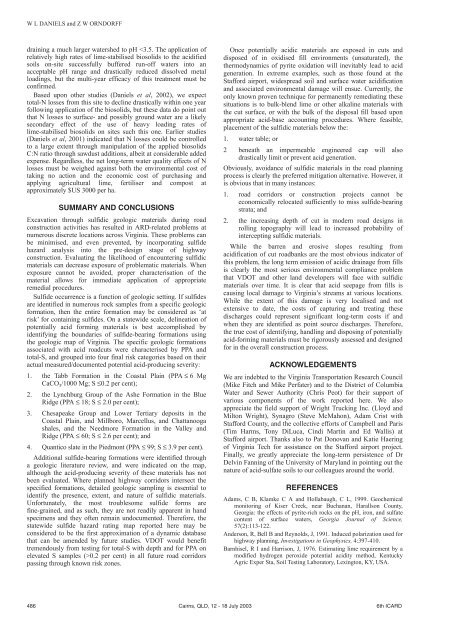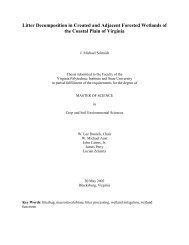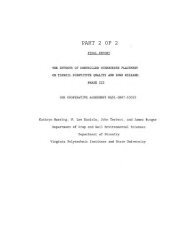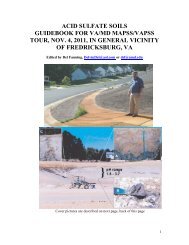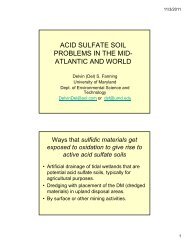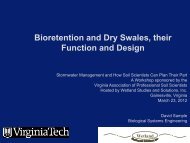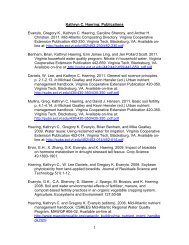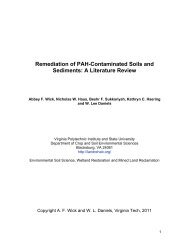Daniels and Orndorff, 2003 ICARD Acid Rock Drainage
Daniels and Orndorff, 2003 ICARD Acid Rock Drainage
Daniels and Orndorff, 2003 ICARD Acid Rock Drainage
Create successful ePaper yourself
Turn your PDF publications into a flip-book with our unique Google optimized e-Paper software.
W L DANIELS <strong>and</strong> Z W ORNDORFF<br />
draining a much larger watershed to pH 0.2 per cent) in all future road corridors<br />
passing through known risk zones.<br />
Once potentially acidic materials are exposed in cuts <strong>and</strong><br />
disposed of in oxidised fill environments (unsaturated), the<br />
thermodynamics of pyrite oxidation will inevitably lead to acid<br />
generation. In extreme examples, such as those found at the<br />
Stafford airport, widespread soil <strong>and</strong> surface water acidification<br />
<strong>and</strong> associated environmental damage will ensue. Currently, the<br />
only known proven technique for permanently remediating these<br />
situations is to bulk-blend lime or other alkaline materials with<br />
the cut surface, or with the bulk of the disposal fill based upon<br />
appropriate acid-base accounting procedures. Where feasible,<br />
placement of the sulfidic materials below the:<br />
1. water table; or<br />
2 beneath an impermeable engineered cap will also<br />
drastically limit or prevent acid generation.<br />
Obviously, avoidance of sulfidic materials in the road planning<br />
process is clearly the preferred mitigation alternative. However, it<br />
is obvious that in many instances:<br />
1. road corridors or construction projects cannot be<br />
economically relocated sufficiently to miss sulfide-bearing<br />
strata; <strong>and</strong><br />
2. the increasing depth of cut in modern road designs in<br />
rolling topography will lead to increased probability of<br />
intercepting sulfidic materials.<br />
While the barren <strong>and</strong> erosive slopes resulting from<br />
acidification of cut roadbanks are the most obvious indicator of<br />
this problem, the long term emission of acidic drainage from fills<br />
is clearly the most serious environmental compliance problem<br />
that VDOT <strong>and</strong> other l<strong>and</strong> developers will face with sulfidic<br />
materials over time. It is clear that acid seepage from fills is<br />
causing local damage to Virginia’s streams at various locations.<br />
While the extent of this damage is very localised <strong>and</strong> not<br />
extensive to date, the costs of capturing <strong>and</strong> treating these<br />
discharges could represent significant long-term costs if <strong>and</strong><br />
when they are identified as point source discharges. Therefore,<br />
the true cost of identifying, h<strong>and</strong>ling <strong>and</strong> disposing of potentially<br />
acid-forming materials must be rigorously assessed <strong>and</strong> designed<br />
for in the overall construction process.<br />
ACKNOWLEDGEMENTS<br />
We are indebted to the Virginia Transportation Research Council<br />
(Mike Fitch <strong>and</strong> Mike Perfater) <strong>and</strong> to the District of Columbia<br />
Water <strong>and</strong> Sewer Authority (Chris Peot) for their support of<br />
various components of the work reported here. We also<br />
appreciate the field support of Wright Trucking Inc. (Lloyd <strong>and</strong><br />
Milton Wright), Synagro (Steve McMahon), Adam Crist with<br />
Stafford County, <strong>and</strong> the collective efforts of Campbell <strong>and</strong> Paris<br />
(Tim Harms, Tony DiLuca, Cindi Martin <strong>and</strong> Ed Wallis) at<br />
Stafford airport. Thanks also to Pat Donovan <strong>and</strong> Katie Haering<br />
of Virginia Tech for assistance on the Stafford airport project.<br />
Finally, we greatly appreciate the long-term persistence of Dr<br />
Delvin Fanning of the University of Maryl<strong>and</strong> in pointing out the<br />
nature of acid-sulfate soils to our colleagues around the world.<br />
REFERENCES<br />
Adams, C B, Klamke C A <strong>and</strong> Hollabaugh, C L, 1999. Geochemical<br />
monitoring of Kiser Creek, near Buchanan, Harallson County,<br />
Georgia: the effects of pyrite-rich rocks on the pH, iron, <strong>and</strong> sulfate<br />
content of surface waters, Georgia Journal of Science,<br />
57(2):113-122.<br />
Anderson, R, Bell B <strong>and</strong> Reynolds, J, 1991. Induced polarization used for<br />
highway planning, Investigations in Geophysics, 4:397-410.<br />
Barnhisel, R I <strong>and</strong> Harrison, J, 1976. Estimating lime requirement by a<br />
modified hydrogen peroxide potential acidity method, Kentucky<br />
Agric Exper Sta, Soil Testing Laboratory, Lexington, KY, USA.<br />
486 Cairns, QLD, 12 - 18 July <strong>2003</strong> 6th <strong>ICARD</strong>


